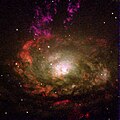Plik:Circinus.galaxy.750pix.jpg

Rozmiar podglądu – 600 × 600 pikseli. Inne rozdzielczości: 240 × 240 pikseli | 480 × 480 pikseli | 747 × 747 pikseli.
Rozmiar pierwotny (747 × 747 pikseli, rozmiar pliku: 928 KB, typ MIME: image/jpeg)
Historia pliku
Kliknij na datę/czas, aby zobaczyć, jak plik wyglądał w tym czasie.
| Data i czas | Miniatura | Wymiary | Użytkownik | Opis | |
|---|---|---|---|---|---|
| aktualny | 18:07, 13 cze 2011 |  | 747 × 747 (928 KB) | Mylius | Better quality, converted from original TIFF |
| 13:14, 31 paź 2005 |  | 600 × 599 (82 KB) | Kauczuk | Galaktyka typu Seyferta w Cyrklu (Circinus). Galaktyka leży 13 milionów lat świetlnych stąd w południowej konstelacji Cyrkla. Jej typ to Seyfert II, będący klasą głównie spiralnych galaktyk posiadających zwarte centra, w których jak sie uważa |
Lokalne wykorzystanie pliku
Poniższa strona korzysta z tego pliku:
Globalne wykorzystanie pliku
Ten plik jest wykorzystywany także w innych projektach wiki:
- Wykorzystanie na af.wikipedia.org
- Wykorzystanie na ar.wikipedia.org
- Wykorzystanie na ast.wikipedia.org
- Wykorzystanie na beta.wikiversity.org
- Wykorzystanie na br.wikipedia.org
- Wykorzystanie na bs.wikipedia.org
- Wykorzystanie na ca.wikipedia.org
- Wykorzystanie na ceb.wikipedia.org
- Wykorzystanie na cs.wikipedia.org
- Wykorzystanie na cy.wikipedia.org
- Wykorzystanie na da.wikipedia.org
- Wykorzystanie na de.wikipedia.org
- Wykorzystanie na el.wikipedia.org
- Wykorzystanie na en.wikipedia.org
- Wykorzystanie na en.wikiversity.org
- Wykorzystanie na eo.wikipedia.org
- Wykorzystanie na es.wikipedia.org
- Wykorzystanie na et.wikipedia.org
- Wykorzystanie na eu.wikipedia.org
- Wykorzystanie na fa.wikipedia.org
- Wykorzystanie na fr.wikipedia.org
Pokaż listę globalnego wykorzystania tego pliku.

